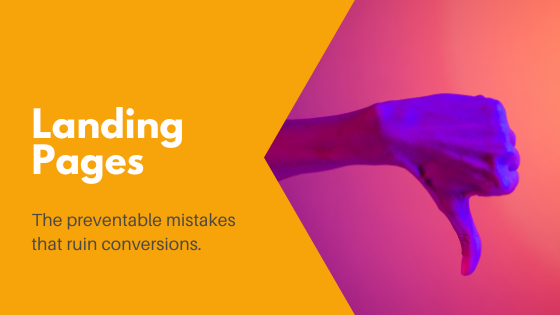Warning: These landing page mistakes instantly ruin conversions.

These are the landing page mistakes you DON’T want to make
Our series on landing pages has covered everything from benefits of landing pages and the different types of landing pages you can build (plus how to choose what you actually need) to 17 landing page ideas your brand can use and the do’s and don’ts worth knowing.
In this post, we’ll expose the most common mistakes people make when creating their first landing page. These oversights don’t just ruin your conversion rate—they result in bad landing pages, period!

Problem #1: Page load speed
Consider these findings:
- 47% of customers expect a webpage to load in 2 seconds or less.
- 40% of visitors abandon a website if it takes more than 3 seconds to load.
- A 1-second delay in page load time results in 11% loss of page views.
Conclusion? People are impatient. There’s also no shortage of other offers—your competitors—to choose from if they just click the back button. So if your landing page is slow to load, then be prepared to lose a good number of visitors.
Problem #2: Poorly-written copy
It goes without saying that what and how you write matters. There are two components to this.
First, bad landing pages are those where the copy doesn’t resonate with target buyer personas; where what you write fails to consider search intent; and where you don’t address a particular stage in the purchase journey. That is, the landing page copy doesn’t particularly help the reader.
That aside, equally important are good grammar (although you can break a few rules here and there, where it makes sense to do so); correct punctuation and proper spelling; and text that has a logical flow.
By the way, this landing page mistake is 100% preventable. Instead of winging it, you can work with a pro copywriter (like me) to develop high-impact, high-converting landing page copy.
Problem #3: More than one call to action
It’s a lot easier to convince someone to do one thing than persuade them to do two or three. That’s why the most effective landing pages only have one call to action. They don’t want to confuse, distract, or overwhelm readers with options and, in the end, deter visitors from doing anything at all.
Problem #4: Messy pages
The way your page looks plays an important role in sealing the deal. After all, appearance influences perception. It’s also a reflection of your brand!
Choosing stylish but hard-to-read fonts, opting for too-small or too-large font sizes, and an all-over-the-place, cluttered layout are all guaranteed conversion-killing landing page mistakes. Just don’t do it!
Problem #5: Low-quality images
Unless the focus of your landing page is a video, almost all landing pages will have at least one image: the hero image! But you can’t just use any old photograph you have on hand. They must be relevant, add context, relate to your message and be of a high quality.
For example: If your landing page is about dog grooming services, the images you use should be related to dog grooming. A photo of kibble wouldn’t be appropriate.
Problem #6: The benefits aren’t clear
Self-serving copy is another common landing page mistake and it’s quite possibly the worst kind. Why? Because it’s about you, not the customer. And when it’s about you, the offer and associated benefits aren’t clear.
Remember that your readers are all wondering one thing: What’s in it for me? If visitors can’t tell, well, then thank you, next! They’re not going to stick around trying to figure it out.

Problem #7: Your landing page isn’t optimized for mobile devices
A lot of business takes place over mobile devices, which is why it’s a mistake not to build a mobile-friendly landing page! Pages should look just as beautiful and be just as functional on small screens as they are on a PC.
Problem #8: You’re asking for too much information
When it comes to lead capture forms, your inner marketer may be tempted to ask for more information than necessary. The thing is, the more you ask, the less likely someone will carry through with completing the form. Take note: The fewer the required fields, the more conversions.
Problem #9: You publish and then forget about it
Here’s one of the biggest landing page mistakes you can make: Hit publish and leave it at that. The work doesn’t end just because the page is now online. You still need to monitor performance and make adjustments – colors, word choice, placement, image selection – until you find the right “configuration” that will result in maximum conversions.
Pro Tip: Adjust only one element at a time otherwise you won’t know which item was the driving force behind any changes in conversion.